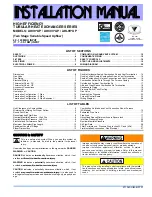
3. Working from furnace to outside, cut pipe to required
length(s).
4. Deburr inside and outside of pipe.
5. Chamfer outside edge of pipe for better distribution of primer
and cement.
6. Clean and dry all surfaces to be joined.
7. Check dry fit of pipe and mark insertion depth on pipe.
8. After pipes have been cut and preassembled, apply generous
layer of cement primer to pipe fitting socket and end of pipe
to insertion mark. Quickly apply approved cement to end of
pipe and fitting socket (over primer). Apply cement in light,
uniform coat on inside of socket to prevent buildup of excess
cement. Apply second coat.
9. While the cement is still wet, twist pipe into socket with a
1/4-turn. Be sure pipe is fully inserted into fitting socket.
10. Wipe excess cement from joint. A continuous bead of cement
will be visible around the perimeter of a properly made joint.
11. Handle pipe joints carefully until cement sets.
12. Support piping at minimum of every 5 ft (3 ft for SDR-21 or
-26 PVC) using perforated metal hanging strap. Slope
combustion-air and vent pipes toward furnace a minimum of
1/4 in. per linear ft with no sags between hangers.
13. Use appropriate methods to seal openings where vent and
combustion-air pipes pass through roof or side wall.
Step 8—Vent Terminal Kit Installation
The combustion-air and vent pipes must terminate outside the
structure. A factory-supplied terminal kit must be installed as in 1
of the installations shown in Fig. 6 or 7. A roof termination is
preferred. The combustion-air inlet fitting is the factory-provided
elbow with air splitter. (See Fig. 7.)
1. Roof termination is preferred. (See Fig. 7.)
a. Inlet of combustion-air pipe must terminate no less than 12
in. above roof or snow accumulation level.
b. Inlet of combustion-air pipe must terminate 12 in. away
from vertical wall or other protrusion.
2. Termination through existing chimney may be used provided:
a. No other gas-fired or wood-burning appliance is vented
into chimney.
b. Both combustion-air and vent pipes run entire length of
chimney.
c. Top of chimney is sealed and weatherproofed.
3. Sidewall termination. (See Fig. 6.)
a. Terminations must be made 12 in. above anticipated annual
snow accumulation level or grade, whichever is greater.
b. Minimum of 4 ft clearance must be provided from electric
or gas meters, regulators, and relief equipment.
4. Install 90° elbows as shown in Fig. 6 or 7, or use a 180°
U-fitting.
5. Install tee as shown in Fig. 6 or 7.
6. Check required dimensions as shown in Fig. 6 or 7.
7. Disassemble loose pipe fittings. Clean and cement fittings
using same procedures as outlined for system piping.
8. Secure combustion-air and vent pipe terminations with
Z-shaped termination bracket (provided).
MULTIVENTING AND VENT TERMINATIONS OF 58EJB
FURNACES — When 2 or more 58EJB Furnaces are vented near
each other, each furnace must be individually vented. Never
common vent or breach-vent these furnaces. There must be a
12-in. separation between the combustion-air and vent pipes of the
first and second furnaces. The next vent termination must be at
least 4 ft away from the first 2 terminations. It is important that the
vent terminations be constructed in this manner to avoid recircu-
lation of flue gases.
Step 9—Condensate Drainage
This furnace must use the condensate trap supplied with the unit.
See Fig. 9 for proper drain installation. The drain must terminate
at a floor drain, sewer system, or drain vent for proper condensate
removal. Drain installation must conform with local building
codes. For proper condensate drainage from the furnace, the
furnace MUST be within 1/2 in. of level. That is, the highest corner
of the furnace must not be more than 1/2 in. higher than the lowest
corner.
NOTE:
The condensate trap MUST be connected to the PVC tee
on the drain line exiting the unit as shown in Fig. 9. Failure to
place the trap at this location may cause erratic unit operation and
nuisance furnace shutdown.
The 1/2-in. diameter schedule-40 PVC or CPVC condensate drain
piping and pipe fittings must conform to ANSI standards and
ASTM D1785 or D2846. The schedule-40 PVC or CPVC cement
and primer must conform to ASTM D2564 or F493.
Fig. 8—Combustion-Air Piping
A91215
AIR INLET
PIPE
DO NOT SEAL
THIS JOINT
COMBUSTION-AIR INLET PLATE
In all installations the
combustion-air inlet
piping must be connected
with an elbow pointing up
to allow access to the
burner assembly.
NOTE:
Fig. 9—Condensate Drain System
A91176
1
″
INDUCER
HOUSING
TUBE
VENT DRAIN
TUBE
TO VENT
TERMINATION
Connect to approved
sewer system per these
instructions and local
codes.
NOTE:
8


































